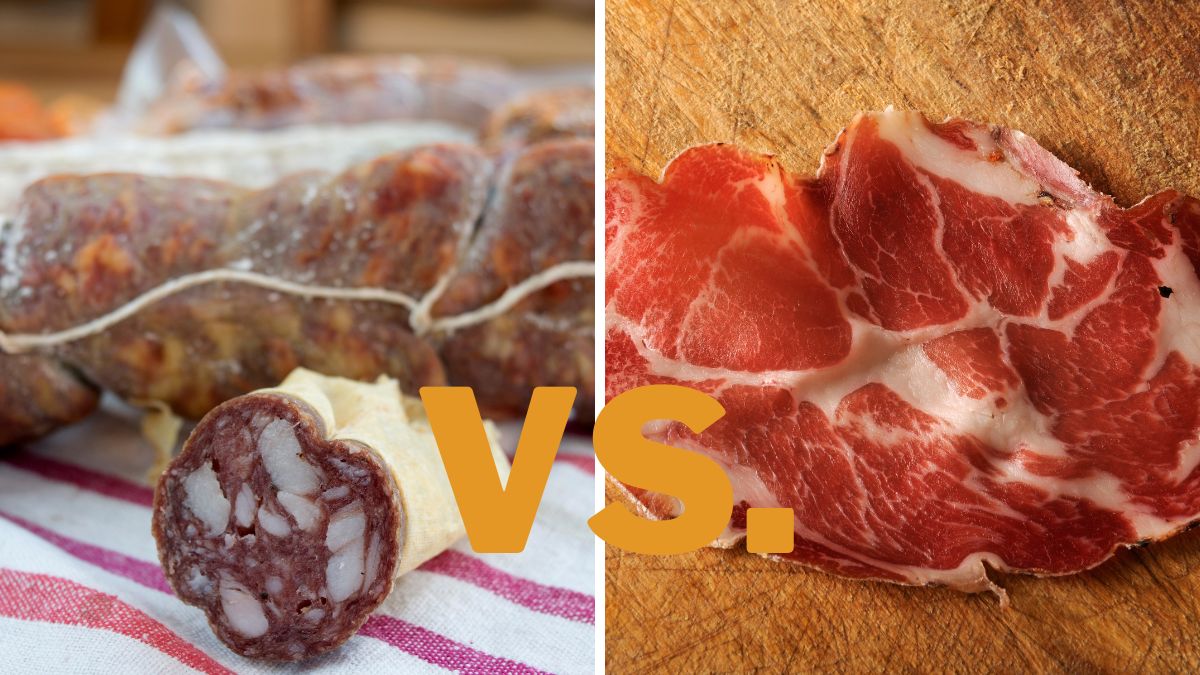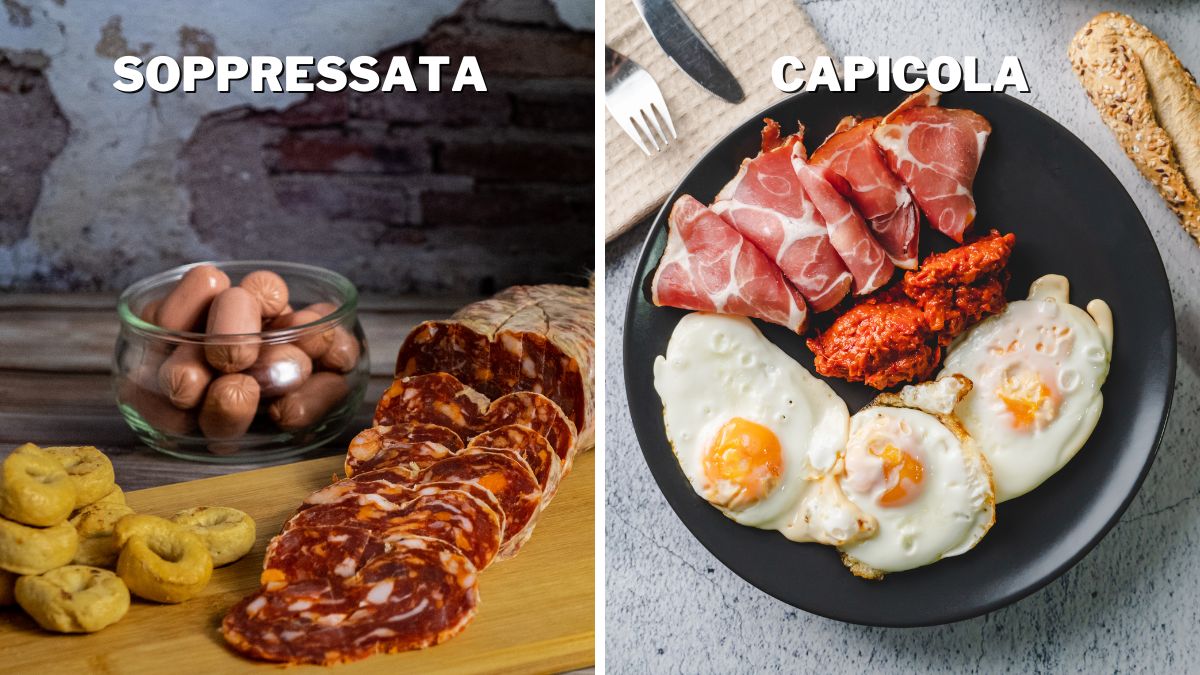Soppressata vs. Capicola: Differences & Uses

Italians take their deli meat very seriously, so it’s no surprise that you’ll taste the best cuts there. I got to experience it first-hand on my recent trip to Italy, and I’ve got to say — I’ve never tasted better deli meat! Soppressata and capicola are both pork and have similar spices, but very different flavors! They can be sweet, spicy, smoky, and everything in between, and that’s why you can serve them with anything! For you to choose your fav, it’s essential to compare. So, what’s the difference between soppressata and capicola?
You’ll need ground meat for making soppressata, but whole cuts for capicola. They are both packed with flavors, but capicola has a more delicate taste since it’s thinly cut, unlike soppressata which is thicker. If you love a good panini, go for capicola, but for pizza, soppressata is the right choice!
Tasting Italian deli meats is the moment when salami becomes fine food! My favorites are antipasto boards with fancy cheeses, olives, crackers, and salami as a star! Read on to get insight into the differences, nutrition, taste, and serving style of soppressata and capicola!
Differences in Ingredients and Varieties
When it comes to choosing the right cut of meat, both of these deli meats require lean pork. When preparing soppressata, opt for loin, haunch, filet, shoulder, or ham scraps, but mix it with some fatty parts; for capicola – go for shoulder or neck that are 65-70% lean. Now, let’s speak about seasonings!
Salt and black pepper are staples when making soppressata, while other spices are altered from region to region. The same goes for capicola, though, sea salt and red pepper flakes!
Soppressata originates from South Italy, and its traditional recipe involves dried chili peppers, black pepper, and red wine. If you go northern, you’ll see a whole range of new, unique spice combinations. Garlic, cloves, cinnamon, fennel seeds, hot pepper, and rosemary are all superb ideas and will blend impeccably with pork!
Capicola calls for different aromatic rubs – depending on what flavor you want to achieve: classic, sweet, or herbal. Besides black peppercorns, blend red pepper flakes, fennel, and aniseeds for the classic relish. For a bit of spicy sweetness, exchange coriander seeds for anise – just in a different ratio!
And saved for last is my favorite – herbs-induced capicola with fresh thyme, rosemary, and garlic for a real Italian delicacy! Ready-to-eat capicola has a reddish outer layer that comes from red pepper and paprika, while the soppressata color ranges from pale to deep, almost burgundy, which depends on whether you add wine or not.
Taste
Marbled soppressata has a rather unique taste, and it’s hard to compare it with anything. When you bite into it, saltiness is the first flavor on your palate, then all the other spices follow. It goes from slightly to very spicy, depending on the seasoning choice – but it’s always musky and deeply flavored.
Another interesting thing is that soppressata comes in thick, coarse slices cut solely with a knife, as that’s the best way to enjoy the taste to the maximum.
On the other side, savory capicola is best when paper thin with a distinct smoky relish. It has to be cut like that because otherwise, it would be hard to chew. Besides having fatty parts, they won’t take over the flavor, but salt and spices will.
Overall, soppressata is a real aromatic bite, while capicola is more delicate flavored – but no less tasty at all!
Differences in Preparation
When making soppressata you need to coarsely mince the meat, while capicola requires a whole piece. Then you add wine and spices to the meat, combine it well, and stuff the casings. Keep in mind that well-combined meat will be very sticky and slightly fuzzy, but that’s all right! Now, when it comes to choosing the casing, you can go traditionally with hog middle, beef middle, or collagen casings tied with a string.
Tip: When grinding fat for soppressata, make sure to half-freeze it so it doesn’t melt while mincing.
The whole muscle cut capicola is dry cured and rubbed with spices and/or herbs. The best casing here is beef bung, but also a pig bladder, diaphragm, and collagen or hog sheets. The last but not least important step is drying and fermenting.
Soppressata needs about 40 days to absorb all the flavors and aroma, while capicola needs to stay hung up for 3 to 6 months. They are both the most delicious when cured over smoke because it gives them particular relish. There is also a version of slow-roasted capicola, but its texture is chewier and flavor lighter.
Nutritional Values
Both salami varieties are pretty decent sources of proteins. An oz of soppressata has a few grams of protein more than capicola and a few more grams of fat. You can manipulate those ratios by choosing more or less fatty meat, though, but 70-30% in favor of muscle is top-notch. [1] [2]
Still, these are processed meat packed with sodium, so it’s best to consume them moderately and paired with vegetables and whole grains. [3]
Serving Style

Cold cuts are always a part of charcuterie and antipasto boards, but those two are so delicious that you’ll want to incorporate them into any meal. I appreciate a good deli platter, and I can’t imagine it without slices of capicola side by side with Provolone, Gruyere, aged Cheddar, or any other rich, creamy, and nutty-flavored cheese. To enjoy the rhapsody of taste, cube the cheese and wrap it in capicola slices to experience all the flavor at once.
On the other hand, semi-soft cheeses, like Havarti, pair finely with soppressata enhancing its spiciness. Being Italian salami, both of them pair impeccably with fresh bread from Italian cuisine. Focaccia is a superb choice for a flawless sandwich with soppressata, basil, fresh mozzarella, and roasted peppers!
I think pizza is everyone’s favorite, so if you haven’t tried it topped with soppressata – you have to change that! With homemade olive oil-based dough and fresh tomato and mozzarella, you’ll make a perfect bite! The relish is special because all the juices and flavor will be absorbed into the crust, and it’s really one of my favorite pizza tastes!
Also, capicola with morning eggs definitely makes your breakfast a breakfeast! I love this combination because its delicate taste goes perfectly with the eggs, and combining it with ajvar makes it even better — ajvar gives it the needed sharpness and spiciness. Delicious!
Furthermore, thinly sliced capicola is an excellent choice for paninis, Italian subs, or antipasto salads! The bread choice doesn’t matter as it pairs flawlessly from baguette to ciabatta. I love to toast it, though, to add some crunch along with milky burrata, Dijon mustard, and cornichon.
Good wine and cold cuts make the perfect match, so I would definitely recommend Oaky Chardonnay for soppressata and Shiraz for capicola. I wholeheartedly encourage you to make the most of your deli meat!
